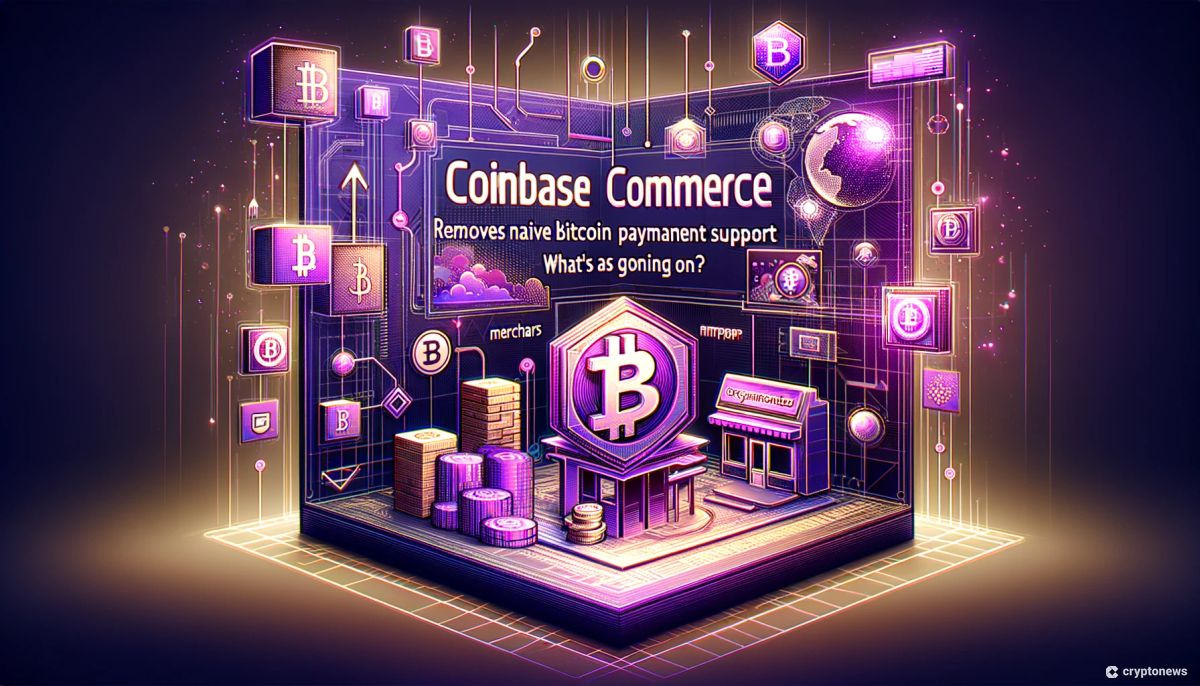Alternative Ways for Coinbase Commerce to Support Native Bitcoin Payments


Last updated:
|
5 minutes reading time


Coinbase recently announced that it will end support for native Bitcoin (BTC) payments on its merchant payments platform, Coinbase Commerce.
The company’s head of product, Lauren Dowling, stated on her ) and limited asset support.”

As a result, Dowling explained in her X thread all the ways users can continue to use Coinbase Commerce for payments.
Dowling also responded to a user comment, noting that “Coinbase Commerce will be moving all users to the new version of the product on April 15th.”
Is Coinbase moving away from Bitcoin?
Unsurprisingly, the discontinuation of support for native Bitcoin payments by Coinbase Commerce – one of the largest cryptocurrency payment processors – has caused controversy in the industry.
Joe Nakamoto, a Bitcoin journalist, told Cryptonews that he believes Coinbase has deviated from the core principles of Bitcoin.
“Bitcoin reflects peer-to-peer financing, privacy and the freedom to transact without intermediaries,” said Nakamoto. “The decision to remove real Bitcoin reflects this.”
Coinbase Commerce continues to allow customers to pay with unspent transaction output assets (UTXO), such as Bitcoin, from their Coinbase account.
According to Dowling’s X-Thread, this accounts for a significant portion of the Bitcoin volume that Coinbase Commerce processes.
Native Bitcoin Payment Alternatives
Interestingly, Rena Shah, vice president of operations and strategy at Trust Machines – a development team building the Bitcoin ecosystem – told Cryptonews that native Bitcoin payments have always presented a bit of a challenge.
“There is a challenge in terms of coordination, both on-chain and off-chain protocols,” Shah said. “On-chain fees also fluctuate with miner activity and on-chain demand.”
Shah further explained that Coinbase Commerce’s decision to continue supporting UTXO assets like Bitcoin could make payments easier .
“A UTXO represents a specific amount of Bitcoin that has been authorized by a sender and can be spent by a recipient,” she said.
However, Shah pointed out that Layer 2 (L2) solutions can also ensure seamless native Bitcoin transactions. For example, she noted that Stacks (STX), a Bitcoin L2 infrastructure, can help enable instant Bitcoin payments.
“With accelerators like USDC stablecoins and advanced smart contracting now active at levels like Stacks, Bitcoin can maintain Lindy’s proven security guarantees globally while enabling instant payments, debit services, tokenized assets and more,” she said.
Shah also mentioned that a Bitcoin L2 like Stacks could provide a better solution for native Bitcoin payments compared to the Bitcoin Lightning Network.
The Lightning Network is a peer-to-peer payment protocol based on the Bitcoin blockchain designed to enable instant, secure and semi-private transactions.
Coinbase CEO Brian Armstrong recently stated on his X account that the company is in the process of integrating the Lightning Network into Coinbase.
While the Lightning Network could bring back support for native Bitcoin payments on Coinbase, Shah explained that a Bitcoin L2 may be a better solution.
“With a Bitcoin L2, you no longer need to use Bitcoin’s base layer. This means the transaction time would be shorter, which would prove to be a better solution for everyday payments,” she said.
Shah further pointed out that the current transaction fee for low priority transactions on Stacks is only 44 cents.
“Payments are a large part of how everyday users use Bitcoin, and unlocking the ability to seamlessly transact without losing the benefits of the Bitcoin base layer must be a priority,” noted Shah.
Lightning Network vs. Bitcoin L2
While a Bitcoin L2 like Stacks can help ensure easier native Bitcoin transactions, Nakamoto explained that the Lightning Network may be the best option for a platform like Coinbase.
“Companies like Kraken, CoinCorner, Relai, River and OKX have all integrated Lightning as a spending, payment and even savings solution,” Nakamoto said. “Some of them have had Lightning for years, so what’s stopping Coinbase?”
In fact, usage of the Lightning Network is increasing rapidly. Data from a report published by pure-play Bitcoin exchange River shows that the Lightning Network experienced an estimated growth of 1,212% in two years between August 2021 and 2023.
The results show that around 6.6 million forwarded transactions took place in August last year. This represents a significant increase compared to the 503,000 transactions in August 2021.
Although notable, Mark Hendrickson, general manager at Bitcoin-only wallet provider Leather, told Cryptonews that he believes platforms like Coinbase have the opportunity have to emphasize that Bitcoin requires blockchain-based L2s instead of peer-to-peer networks like Lightning.
“This is really due to the smart contract benefits that L2s like stacks bring,” said Hendrickson.
With this in mind, Hendrickson pointed out that it may be easier for companies like Coinbase to integrate some form of blockchain-based L2s alongside its Ethereum Virtual Machine (EVM)-based L2s.
As Armstrong mentioned on X, Coinbase Commerce uses “a new EVM payment protocol.” He also wrote: “We believe that paying with crypto in the future will be primarily Layer 2, and we want to help make that happen.”
According to Hendrickson, a Bitcoin L2 – like stacks – works compared to one Peer-to-peer network like Lightning similar to an EVM L2.
“If Coinbase is looking for integrations that are built to last not just the next bull market, but any bull market, then blockchain-based L2s will prevail,” he noted.
Challenges may hinder the adoption of native BTC payments
Although there are alternative solutions for implementing native Bitcoin payments on Coinbase Commerce, it may take some time for the platform to move forward.
For example, Nakamoto remains skeptical that Coinbase will support the Lightning Network.
“Brian Armstrong used to be a Bitcoin proponent, but he has fallen victim to the ‘innovation’ in crypto and Web3,” he said. “It is failing to keep up with the innovation and development of Bitcoin. For example, he recently confused my Bitcoin Lightning address with an email address.”
Additionally, Shah believes that Coinbase has not yet explored Bitcoin L2 solutions like Stack.
“The Stacks ecosystem is going through a hard fork, so perhaps Coinbase will add Stacks to its radar after that,” she said.
Shah added that Stacks is based on the Clarity smart contract language. Still, most L2 EVMs are based on Solidity, a more popular smart contract language.
Despite these challenges, Shah believes that most Bitcoin transactions will take place over L2 infrastructure.
“I expect that already after this year’s halving, Bitcoin will increasingly rely on its Layer 2 infrastructure for most transactions, while the base layer focuses on high-value settlements.”






